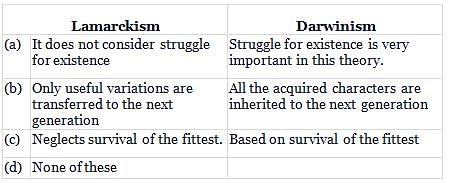Test: Theories of Evolution (NCERT) - NEET MCQ
15 Questions MCQ Test Biology Class 12 - Test: Theories of Evolution (NCERT)
Which of the following evidences does not favour the Lamarckian concept of inheritance of acquired characters?
The diversity in the type of beaks of finches adapted to different feeding habits on the Galapagos Islands, as observed by Darwin, provides evidence for
| 1 Crore+ students have signed up on EduRev. Have you? Download the App |
Single step large mutation leading to speciation is also called
By the statement "Survival of the Fittest" Darwin meant that...............
Which of the following are the two key concepts of Darwinian theory of evolution?
"Human population grows in geometric ratio while food materials increase in arithmetic proportion." It is a statement from
Consider the following three statements and select the correct option stating which one is true (T) and which one is false (F)
(i) Oparin of Russia and Haldane of England proposed that the first form of life could have come from pre-existing non-living organic molecules (e.g., RNA, protein, etc.) and that formation of life was preceded by chemical evolution
(ii) Based on observations made during a sea voyage around the world, Charles Darwin concluded that existing living forms share similarities to varying degrees only among themselves
(iii) Evolution by natural selection must have started when cellular forms of life with different metabolic capability originated on Earth

Read the following statements carefully and select the correct ones
(i) Alfred Wallace, a naturalist who worked in Malay Archipelago had also come to similar conclusions as Darwin around the same time
(ii) August Weismann by careful experimentation demonstrated that life comes only from pre-existing life.
(iii) The organs which have the same fundamental structure but are different in functions are called homologous organs
(iv) Rate of appearance' of new. form is inversely proportional to life span of organism
According to Lamarckism, long necked giraffes evolved because
Which of the following differences between Lamarckism and Darwinism is incorrect?

Which one of the following sequences was proposed by Darwin and Wallace for organic evolution?
Which one of the following phenomena supports Darwin's concept of natural selection in organic evolution?
Which one of the following scientist's name is correctly matched with the theory put forth by him?
Each of us is part of the ongoing evolution of the species. Which of the following occurrences would have the greatest impact on the future biological evolution of the human population?
|
86 videos|294 docs|184 tests
|

















